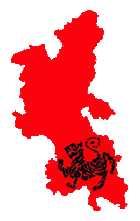Not a huge turnout this evening but those who turned up, trained hard! I cannot ask for a lot more. 13 students split 6 / 7 between big grades and 4th kyu and below. The lesson started off after a great warm up by Carlos but I don't think the students were expecting the basics they got. Ramped it up a bit for the lower grades and something totally different for the high grades - just like Tuesday and Wednesdays classes.
Everyone was lead through a version of Taikyoku Nidan / Sandan and having got halfway through, left the lower grades to work the rest out for themselves. Meanwhile, the high grades were taken through Ji'in. Thankfully, due to the weird combinations I made them go through at the start of the lesson, this made teaching the kata so much easier. Only one of the students had done the kata before but this was years and years ago.
Ji'in is important for the execution of many simultaneous techniques and the often-repeated stances, enabling swift changes of direction while maintaining balance, power and steps of equal length. It has, however, been removed from the Japan Karate Association teaching and grading syllabus. Despite that, it is such a nice kata.


1 comment:
This kata was one of only two not included in the ‘Best Karate’ series by M. Nakayama, the series widely recognised as the definitive kata reference. The reason for this is not truly known, although there have been many theories for why they were not included. Nonetheless, the kata is still widely practiced by many associations.
The origins of the kata are not fully known, although it was at one stage unsuccessfully named Shokyo. This kata shares its Yoi position with Jion and Jitte, and the symbolic significance of the gesture also applies here.
This kata, despite no longer being recognised by many associations, does have many instructional qualities that are of much value to any karateka.
At one stage in the kata, the practitioner will spin twice in kiba-dachi then step for the third count. To do this effectively requires much skill, and to effectively do so requires development of balance and co-ordination.
This is a very powerful kata, and although not as flashy as many of the other katas, it is of high value to all karateka.
Post a Comment